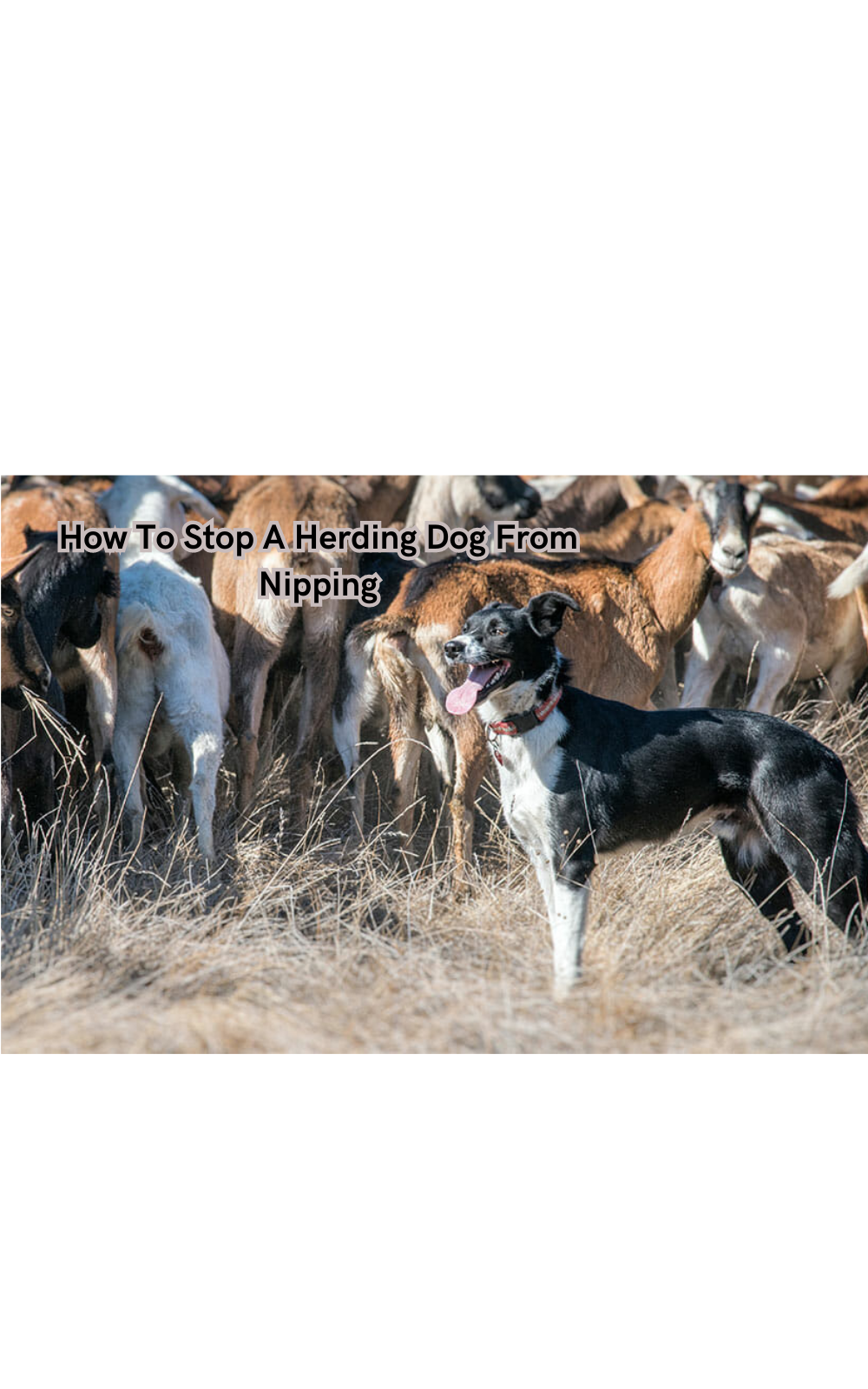How To Stop A Herding Dog From Nipping
Pet owners can effectively mitigate nipping behaviors by implementing positive reinforcement techniques, redirecting their focus, and ensuring ample exercise and mental stimulation.

Nipping is an expected behavior exhibited by herding dogs due to their instinctual herding nature. Addressing and curbing this tendency is crucial for a well-behaved pet. Training a herding dog to stop nipping requires a tailored approach considering their breed-specific traits and energy levels.
Pet owners can effectively mitigate nipping behaviors by implementing positive reinforcement techniques, redirecting their focus, and ensuring ample exercise and mental stimulation.
Understanding the underlying instincts driving this behavior is critical to developing a successful training strategy. You can cultivate a respectful and fulfilling relationship with your beloved pet with patience, consistent training, and a deep understanding of your herding dog's needs.
Why Do Herding Dogs Nip?
Herding dogs have been bred for centuries to work closely with humans and livestock, using their instincts to control the movement of animals.
This includes nipping at the heels or sides of animals to guide them in a specific direction. However, these behaviors can be deemed unacceptable and even dangerous when living in a domestic setting.
In addition to their innate herding instincts, dogs are highly intelligent and energetic breeds. They may resort to nipping to release pent-up frustration or boredom without proper outlets for their physical and mental energy.
Herding breeds such as Border Collies, Australian Shepherds, and Australian Cattle Dogs are particularly prone to this behavior. Herding instinct and high energy levels can make nipping challenging to manage.
How To Stop A Herding Dog From Nipping
Now that we understand the root cause of nipping in herding dogs let's explore effective ways to stop this behavior.
Positive Reinforcement Training:
Positive reinforcement training is an effective method for addressing nipping behaviors in herding dogs. This involves rewarding desired behaviors with treats, praise, and attention while ignoring or redirecting unwanted behaviors.
Consistency is key in positive reinforcement training. It is important to consistently reward good behaviors and redirect or ignore unwanted behaviors every time they occur. This helps your dog understand what is expected of them and encourages them to repeat the desired behavior.
Dial In the Basic Commands:
Teaching your herding dog basic commands such as "leave it," "drop it," and "stay" is crucial when addressing nipping behaviors.
These commands can help redirect your dog's focus from nipping to more appropriate behaviors, such as sitting or lying down.
An Australian shepherd learning to obey the "leave it" command can prevent nipping behaviors in a controlled environment. And dog owners can slowly increase the level of distraction until their pet is able to obey the command in any situation.
Exercise and Mental Stimulation:
Herding breeds require a significant amount of physical exercise and mental stimulation to stay happy and healthy. Without proper outlets for their energy, they may become bored and resort to nipping as a way to release pent-up frustration.
Make sure your dog gets at least an hour of physical exercise each day through activities such as walks, hikes, or playing fetch.
Mental stimulation can be provided through training sessions, puzzle toys, or interactive games with their owners. Dog's behaviors often reflect their level of physical and mental stimulation, so providing adequate outlets for both is crucial in curbing nipping behaviors.
Leash Training:
Leash training is an important aspect of nipping prevention in herding dogs.
By keeping your dog on a leash, you have more control over their movements and can prevent them from getting too close to potential nipping targets, such as other animals or people. Dog behavior can also be managed and corrected more effectively while on a leash. Dog bad behavior can be best managed by leash training.
This also allows you to redirect their focus if they start exhibiting unwanted behaviors. Nipping behavior should never be tolerated, even in play. Make sure to redirect your dog's focus and reward them for good behavior when on a leash.
Watch for Nipping Cues:
As a pet owner, it is important to be aware of your dog's body language and cues before they nip.
Common nipping cues in herding dogs include low growling, intense staring, and crouching down in preparation to pounce. If you notice these cues, redirect your dog's attention immediately through a command or by offering them an appropriate chew toy.
Nipping behavior can also be triggered by overstimulation, so it is important to give your dog breaks from high-energy situations when necessary.
Keep a Toy on Hand to Redirect:
Lastly, it is important to keep a toy on hand at all times to redirect your dog's focus if they start nipping. This can be a chew toy or a tug-of-war toy that allows them to release their energy in an appropriate manner.
By offering them an alternative outlet for their herding instincts, you can help curb nipping behaviors.
Dog breeds like Border Collies and Australian Cattle Dogs may benefit from specialized toys designed for herding breeds, such as puzzle toys that mimic the movement of livestock.
Ignore the Herding Behavior When It Happens:
While it is important to redirect unwanted behaviors, it is equally crucial to avoid rewarding them with attention.
If your herding dog nips at you, immediately stop giving them any attention or treats and walk away. This teaches your dog that nipping results in the opposite of what they want - attention and rewards.
These are just a few effective ways to stop a herding dog from nipping. It is important to remember that every dog is different, and it may take time and patience to find the right approach for your pet.
Additional Ways to Manage Nipping Behaviors
Aside from the training methods mentioned above, there are other ways to manage nipping behaviors in herding dogs. These include:
- Socialization: Exposing your dog to different people and animals at an early age can help reduce their tendency to nip. Dog nipping is often a result of fear or lack of socialization, so introducing your dog to new environments and experiences can help them become more confident and less likely to nip.
- Professional Training: Seeking guidance from a professional dog trainer can be beneficial in developing a personalized training plan for your dog's specific needs. Dog bites and nipping behaviors can be dangerous, so it is important to address them with the help of a professional.
- Consistent Boundaries: Setting consistent boundaries and rules for your herding dog can help reduce confusion and prevent nipping behaviors.
- Time Outs: If your herding dog continues to nip despite training efforts, a short time out in a quiet room can be an effective way to show them that this behavior is not acceptable.
Remember, addressing nipping behaviors in herding dogs requires patience, consistency, and positive reinforcement. Dog biting and nipping is a natural behavior for these breeds, but with proper training and management, it can be redirected to more appropriate behaviors.
Now, You Can Start To Extinguish Unwanted Herding Behavior
You can effectively manage and reduce nipping behaviors in your herding dog by implementing the tips and techniques mentioned above.
Remember to provide plenty of physical exercise and mental stimulation, use leash training to control their movements, watch for nipping cues, and redirect their focus with appropriate toys. With patience and consistency, your dog will learn that nipping is unacceptable, and you can enjoy a well-behaved canine companion.
Furthermore, it is important to address nipping behaviors as soon as they start, as they can escalate into more serious biting behaviors if left unchecked. By being proactive and implementing the tips and techniques discussed in this guide, you can prevent nipping from becoming a bigger problem.
Should you Break out the Water Bottles, Air Cans, and Shock Collars?
No. While those methods may work in the short term, they can negatively affect your dog and worsen their behavior in the long run. Positive reinforcement and redirection are more effective and humane ways to address nipping behaviors in herding dogs. Remember to always be patient, consistent, and understanding with your furry friend as you work towards extinguishing unwanted herding behaviors.
So, instead of resorting to harsh disciplinary measures, try using positive reinforcement techniques and seek guidance from a professional trainer if needed.
With time, patience, and effort, you can successfully manage nipping behaviors in your herding dog and enjoy a well-behaved canine companion.
FAQs
Should I punish my dog for nipping?
Dog bite prevention and management experts strongly recommend against using punishment to address nipping behaviors. This can cause fear, anxiety, and aggression in your dog, worsening the problem. Dog's behavior should be addressed through positive reinforcement and redirection techniques.
What if my herding dog nips at other animals?
If your herding dog exhibits nipping behaviors towards other animals, it is important to intervene and redirect their focus. Consider seeking guidance from a professional trainer to work on your dog's socialization skills and address any underlying fear or aggression issues.
What is the difference between a bite and a nip?
A bite is when a dog uses their teeth to inflict pain or damage, whereas a nip is a quick and light pinch with the teeth. Nipping behaviors are often seen in herding dogs as an inherited trait for controlling livestock, but they should still be addressed and redirected toward appropriate behaviors.
How long does it take to stop nipping behaviors in herding dogs?
The time it takes to stop nipping behaviors in herding dogs can vary depending on the individual dog and their training progress. Most herding dogs can learn to redirect their nipping behavior with consistent training and positive reinforcement within a few weeks or months. However, different breeds like German Shepherd may take longer time.
Conclusion
In conclusion, addressing nipping behaviors in herding dogs demands patience, understanding, and strategic training. By recognizing the innate herding instincts driving this behavior, pet owners can tailor training to redirect this energy positively.
Consistency in applying positive reinforcement techniques, mental stimulation, and physical exercise are pivotal in curbing nipping tendencies. Building a strong bond with your herding dog through trust and communication fosters a respectful and harmonious relationship.
As responsible pet owners, seeking professional guidance is important if encountering challenges in modifying nipping behaviors.
Ultimately, investing time and effort in understanding and training your herding dog can foster a well-mannered and contented companion enriched by a deep sense of mutual understanding and companionship.
